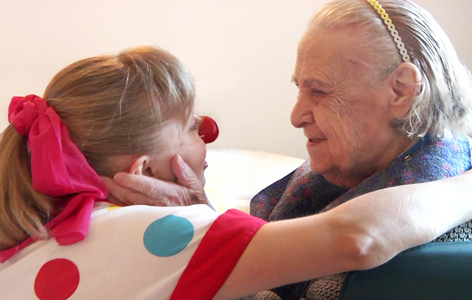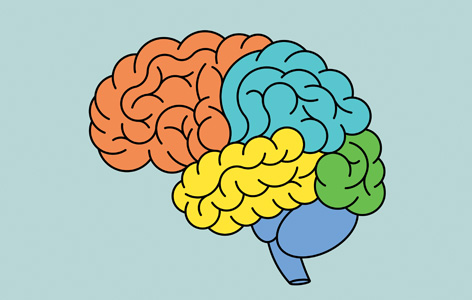 As UHN's monthly research newsletter, NRx reports on the full spectrum of research from UHN's five research institutes: the Princess Margaret (PM) Cancer Centre, the Toronto General Research Institute (TGRI), the Krembil Research Institute (Krembil), the Toronto Rehabilitation Institute (TRI) and the Techna Institute (Techna).
As UHN's monthly research newsletter, NRx reports on the full spectrum of research from UHN's five research institutes: the Princess Margaret (PM) Cancer Centre, the Toronto General Research Institute (TGRI), the Krembil Research Institute (Krembil), the Toronto Rehabilitation Institute (TRI) and the Techna Institute (Techna).
In this issue you can read about:
- A research tool that reveals harmful oxidative stress in cells
- An arts-based approach that can help those with dementia
- Using speech patterns to diagnose ALS and dementia
- How the complexity of cancers can be recreated in the lab
- Treating epilepsy with deep brain stimulation
- Building our vision for the future of research at UHN
We hope that you find NRx informative. If you have feedback or questions, please contact www@uhnresearch.ca.
Christopher J. Paige, PhD, FCAHS
Executive Vice President, Science and Research
University Health Network
An integrated way to sense harmful oxidative damage in live cells has been developed

Reactive oxygen species, such as hydrogen peroxide (illustrated above), are highly unstable molecules that can damage cells through a process known as oxidative stress.
Most of the energy used by the body is produced through a molecular process known as oxidative phosphorylation. While the process is essential for the functioning of the body, it leads to the creation of harmful side products known as reactive oxygen species (ROS).
If left unchecked, free ROS can damage cells, contribute to the development of disease and may even promote aging. Fortunately, there are processes that operate in parallel, known as NADPH antioxidant pathways, that serve to "scavenge" ROS and stop their potentially harmful effects.
Thus, in a cell, the balance between the amount of harmful ROS produced and the activity of antioxidant pathways is critically important—this balance is known as the redox state.
A research team led by TGRI Scientist Dr. Jonathan Rocheleau has developed a new molecular sensor capable of revealing the redox state in cells. The researchers used a diabetes model to verify that the system can monitor oxidative stress.
Comments Dr. Rocheleau, "The sensor, which we named Apollo-NADP+, responds to redox state and can essentially be 'hard-wired' into living cells. This genetically encoded sensor enables the oxidative state of single cells within tissues to be measured with higher reproducibility and accuracy than existing systems."
Future studies that use these tools may shed light on the wide range of diseases implicated in oxidative stress, which include diabetes, neurological diseases, certain cardiovascular diseases and age-related cancers.
This work was supported by the Natural Sciences and Engineering Research Council of Canada, the Canada Foundation for Innovation, the Structural Genomics Consortium and the Toronto General & Western Hospital Foundation.
Apollo-NADP(+): a spectrally tunable family of genetically encoded sensors for NADP. Cameron WD, Bui CV, Hutchinson A, Loppnau P, Gräslund S, Rocheleau JV. Nature Methods. doi: 10.1038/nmeth.3764. 2016 Feb 15. [Pubmed abstract]
Arts-based approaches are effective in improving the quality of life for people with dementia

Elder-clowns go through extensive training to learn how to interact with seniors who have dementia.
Dementia is associated with significant challenges, such as agitation. To manage these challenges, clinicians prescribe medications to modify behavioural and psychological function; however, these drugs have harmful effects, including an increased risk of stroke and death.
Best practices now recommend that before medications are prescribed, alternative approaches be tried first. In particular, arts-based approaches can alleviate the challenges associated with dementia. The most recent of these is the use of professional performers known as elder-clowns. These performers don a red nose and use improvisation, humour, music, empathy and expressive tools to enrich the lives of older adults. There is limited knowledge, however, of the impact of elder-clowning on people with dementia living in nursing homes.
To explore this issue, TRI Senior Scientist Dr. Pia Kontos initiated a study of elder-clowning in the dementia care unit of a nursing home. Her research team used interview-based questionnaires and observational tools to evaluate the effect of elder-clowning on residents with dementia. They found that the residents' agitation decreased and quality of life improved after twelve weeks of elder-clown visits.
The researchers also examined whether elder-clowning affected the impact of dementia symptoms on the provision of care by health care practitioners. Through interview-based questionnaires, the staff reported less disruption in their ability to provide care.
"This is the first study to demonstrate that elder-clowning improves health and the provision of dementia care," says Dr. Kontos. "It provides compelling support for this novel arts-based approach to improve the well-being of people with dementia."
Click here to watch an interview with Dr. Kontos and learn more about her research.
This work was supported by the Canadian Institutes of Health Research and the Toronto Rehab Foundation.
Elder-clowning in long-term dementia care: results of a pilot study. Kontos P, Miller KL, Colobong R, Palma Lazgare LI, Binns M, Low LF, Surr C, Naglie G. Journal of the American Geriatrics Society. doi: 10.1111/jgs.13941. 2016 Feb. [Pubmed abstract]
New speech tool could become the standard for how ALS and dementia are diagnosed

ALS affects the motor neurons in the brain and spinal cord, while FTD only affects the frontal (orange) and temporal (yellow) parts of the brain.
A new study by TRI Affiliate Scientist Dr. Yana Yunusova has revealed that a custom speech pattern detection software may help improve the way two related neurological diseases are detected.
The first disease, referred to as amyotrophic lateral sclerosis (ALS) is caused by rapid deterioration of motor neurons in the brain and spinal cord. It manifests in different forms and can affect an individual's ability to swallow and speak.
The second, termed frontotemporal dementia (FTD), is actually a group of conditions that affect the parts of the brain that control behaviour and the ability to use language appropriately.
Dr. Yunusova conducted a study in which patients with ALS or FTD were asked to read a passage that was recorded and analyzed with custom-made software. By using the software to analyze speech rates, duration of speech and number and duration of pauses, her team was able to identify differences between the different types of ALS and FTD.
"Both of these diseases exist on a continuum where patients with one form often exhibit symptoms of the other," explains Dr. Yunusova. "Our study provides an easy detection tool which may be able to point to which symptoms are predominant in which patients. This could help to improve how accurately clinicians diagnose these conditions."
This work was supported by the National Institutes of Health, the Canadian Institutes of Health Research and the ALS Society of Canada.
Profiling speech and pausing in amyotrophic lateral sclerosis (ALS) and frontotemporal dementia (FTD). Yunusova Y, Graham NL, Shellikeri S, Phuong K, Kulkarni M, Rochon E, Tang-Wai DF, Chow TW, Black SE, Zinman LH, Green JR. PLoS One. doi: 10.1371/journal.pone.0147573. 2016 Jan 20. [Pubmed abstract]
Study demonstrates value of experimental models of cancer made from real patient samples

Cancer cell lines, which are grown on cell culture plates (pictured), can be useful for testing new drugs, but lack important characteristics of real-life disease.
A good model system for scientific research is consistent and reproducible, making it easier to see the effects of your experiment. However, cancer is a disease that has a lot of variability between patients—sometimes even within a single tumour—and many new therapies that appear promising in preliminary studies fail in clinical trials.
A key limitation of experimental models is that they only use one type of cell, while tumours comprise many different cell types. Importantly, these models don't use the cells—known as cancer stem cells (CSCs)—that are thought to be responsible in some cancers for recurrence and treatment resistance.
PM Cancer Centre researcher Dr. Jean Wang and her colleagues have studied CSCs extensively. Recently, they used an experimental model of acute myeloid leukemia (AML) that more accurately reflects the disease. Derived from patient blood samples collected during treatment, this model, which is called a xenograft, captures many of the important clinical features of the human disease, including the presence of CSCs.
The researchers used the largest group of xenograft models reported to date (64 in total) to test the effect of an anticancer drug in AML. In close to 60% of the patient-derived models, the drug was shown to be effective, while the other 40% did not respond. This high degree of variability mirrored what would be expected in real patients in a clinical trial.
Moreover, by comparing the results from the xenograft models with complementary molecular analyses of the patient samples, the researchers were able to identify a biomarker that could be used to predict which models, and therefore which patients, were most likely to respond to the drug.
"Drugs that reduce tumour bulk may not necessarily work against all the cells in the cancer," comments Dr. Wang. "Our integrated approach provides a way to better identify which drugs should move on to clinical trials, while offering a path towards developing biomarkers that can tell us which patients will benefit."
This work was supported by the Canadian Institutes of Health Research, The Princess Margaret Cancer Foundation, the McEwen Centre for Regenerative Medicine, the Terry Fox Foundation, the Ontario Institute for Cancer Research, the Ontario Ministry of Health and Long-Term Care, and the Cancer Stem Cell Consortium with funding from the Government of Canada through Genome Canada and the Ontario Genomics Institute. J Dick holds a Tier 1 Canada Research Chair in Stem Cell Biology. Image source: Wikipedia.
An integrated analysis of heterogeneous drug responses in acute myeloid leukemia that enables the discovery of predictive biomarkers. Chen WC, Yuan JS, Xing Y, Mitchell A, Mbong N, Popescu AC, McLeod J, Gerhard G, Kennedy JA, Bogdanoski G, Lauriault S, Perdu S, Merkulova Y, Minden MD, Hogge DE, Guidos C, Dick JE, Wang JC. Cancer Research. doi: 10.1158/0008-5472.CAN-15-2743. 2016 Feb 1. [Pubmed abstract]
Researchers use deep brain stimulation to reduce the frequency of epileptic seizures

Epileptic seizures are commonly triggered by sleep deprivation, stress, alcohol use or bright flashing lights.
People with epilepsy suffer from debilitating seizures. The current treatment for epilepsy is anti-seizure medication; however, these drugs are not effective in certain individuals.
For individuals with hard-to-treat epilepsy, a therapy known as deep brain stimulation (DBS) may reduce the frequency of seizures. In DBS, electrodes are implanted into the brain and are stimulated to control nerve impulses. It is thought that seizures pass through a region of the brain known as the anterior nucleus, which suggests that targeting this particular area of the brain using DBS may be of benefit; however, the long-term effectiveness of this treatment is not known.
Dr. Andres Lozano (Krembil Senior Scientist and Techna Affiliated Faculty) initiated a study to address this issue. His research team performed anterior nucleus DBS in people with hard-to-treat epilepsy, and asked the study participants to record the frequency of their seizures before and after the treatment.
The research team found that two-thirds of the study participants experienced fewer seizures after long-term DBS treatment; among those who responded to the treatment, the frequency of seizures was reduced by more than half. Using images of the brain from those who responded to DBS, the team located the specific subdivision of the anterior nucleus that received the most intense DBS therapy—suggesting that this subdivision was responsible for controlling the seizures.
"Until now, those with epilepsy who did not respond to conventional treatments represented an unmet clinical need," says Dr. Lozano. "We advocate for more research to identify those who are most likely to benefit from this promising therapy."
This work was supported by the Ronald R. Tasker Chair in Stereotactic and Functional Neurosurgery and the Toronto General & Western Hospital Foundation. A Lozano holds a Tier 1 Canada Research Chair in Neuroscience.
Anterior nucleus deep brain stimulation for refractory epilepsy: insights into patterns of seizure control and efficacious target. Krishna V, King NK, Sammartino F, Strauss I, Andrade DM, Wennberg RM, Lozano AM. Neurosurgery. PubMed PMID: 26813858. 2016 Jan 20. [Pubmed abstract]
UHN President and CEO Dr. Peter Pisters leads townhall to discuss the future of research at UHN

There was a huge turnout at the first of three UHN research Townhall meetings on March 8, 2016. The aim of the meeting was to initiate an ongoing dialogue with the UHN community on the future direction of research at UHN.
As an introduction to the Townhall, Dr. Pisters outlined current challenges that are being faced by UHN's research enterprise, such as the need to align clinical and research operations and growing financial and space constraints.
Dr. Pisters also highlighted the importance of integrating research into the future direction of UHN as a whole. He emphasized that research comprises an important part of UHN's overarching mission—one that the Executive team will be working to drive forward.
In the subsequent question and answer period, attendees were able to ask Dr. Pisters questions relevant to research at UHN, including the future role of commercialization, the challenges facing young investigators and how changes in UHN's organizational structure will impact research.
The next Townhall will be held from 10:00 - 11:00 AM on March 31, 2016 at the Toronto General Hospital DeGasperis Conservatory. Another Townhall will be held from 3:00 - 4:00 PM on April 5 at the BMO Centre in the Krembil Discovery Tower. Everyone working in research is encouraged to attend and participate in the dialogue.
 The Honourable Kirsty Duncan, Minister of Science recently announced that eight UHN researchers will be awarded a total of $8.5 million from the Canada Research Chairs (CRC) program. Four of the eight researchers have been named CRCs for the first time. They are:
The Honourable Kirsty Duncan, Minister of Science recently announced that eight UHN researchers will be awarded a total of $8.5 million from the Canada Research Chairs (CRC) program. Four of the eight researchers have been named CRCs for the first time. They are:  TGRI Senior Scientist Dr.
TGRI Senior Scientist Dr.  TGRI Senior Scientist Dr.
TGRI Senior Scientist Dr.  Senior Scientist and Director of Krembil Research Institute,
Senior Scientist and Director of Krembil Research Institute,  TGRI Scientist Dr.
TGRI Scientist Dr.  TRI Senior Scientist Dr.
TRI Senior Scientist Dr.  TGRI Senior Scientist Dr.
TGRI Senior Scientist Dr.  PM Cancer Centre Senior Scientist Dr.
PM Cancer Centre Senior Scientist Dr.  Krembil Senior Scientist Dr.
Krembil Senior Scientist Dr.  Five UHN researchers were included in a list, prepared by Thomson Reuters, of the world's most influential scientific minds of 2015.
Five UHN researchers were included in a list, prepared by Thomson Reuters, of the world's most influential scientific minds of 2015.